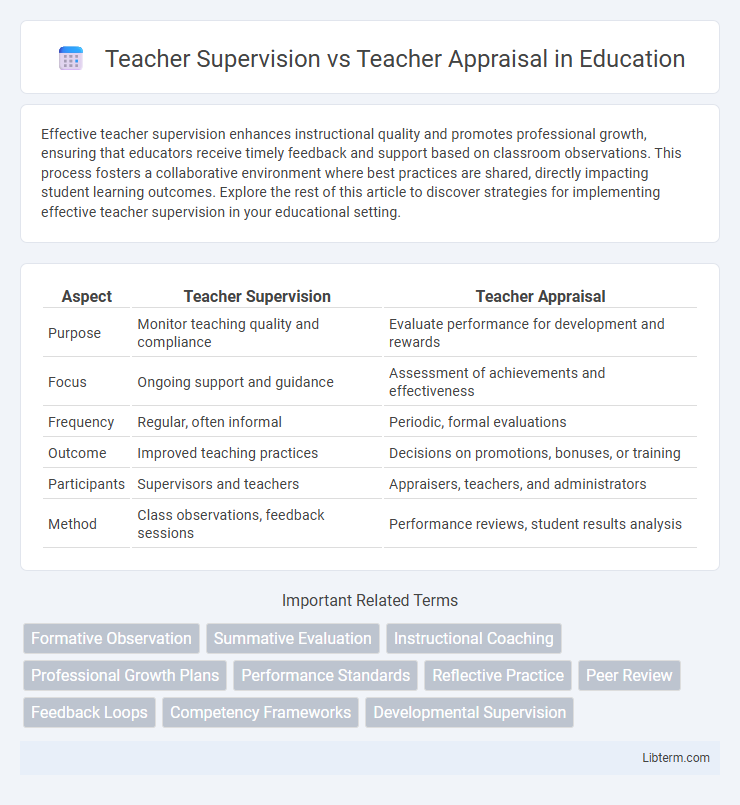Effective teacher supervision enhances instructional quality and promotes professional growth, ensuring that educators receive timely feedback and support based on classroom observations. This process fosters a collaborative environment where best practices are shared, directly impacting student learning outcomes. Explore the rest of this article to discover strategies for implementing effective teacher supervision in your educational setting.
Table of Comparison
| Aspect | Teacher Supervision | Teacher Appraisal |
|---|---|---|
| Purpose | Monitor teaching quality and compliance | Evaluate performance for development and rewards |
| Focus | Ongoing support and guidance | Assessment of achievements and effectiveness |
| Frequency | Regular, often informal | Periodic, formal evaluations |
| Outcome | Improved teaching practices | Decisions on promotions, bonuses, or training |
| Participants | Supervisors and teachers | Appraisers, teachers, and administrators |
| Method | Class observations, feedback sessions | Performance reviews, student results analysis |
Introduction to Teacher Supervision and Appraisal
Teacher supervision involves ongoing guidance and support to enhance instructional practices, focusing on professional growth through observation and feedback. Teacher appraisal is a systematic evaluation process aimed at assessing performance against established standards for accountability and development. Both processes play crucial roles in improving teaching quality and student outcomes within educational settings.
Defining Teacher Supervision
Teacher supervision involves continuous guidance, support, and development of educators through classroom observations, feedback, and professional growth activities. It aims to enhance teaching effectiveness by fostering reflective practices and collaborative improvement rather than merely evaluating performance. Unlike teacher appraisal, which primarily focuses on assessing and rating teacher performance, supervision prioritizes ongoing mentorship and instructional quality enhancement.
Understanding Teacher Appraisal
Teacher appraisal is a systematic process designed to evaluate educators' performance based on predetermined criteria such as teaching effectiveness, student engagement, and professional growth. This evaluation often incorporates multiple data sources, including classroom observations, student feedback, and self-assessments, to provide a comprehensive understanding of teacher competence. Understanding teacher appraisal enables school administrators and stakeholders to make informed decisions about professional development, tenure, and instructional improvements.
Key Differences Between Supervision and Appraisal
Teacher supervision primarily involves ongoing guidance, mentoring, and professional development to support instructional improvement, while teacher appraisal focuses on formal evaluation of performance against set standards for accountability. Supervision emphasizes formative feedback and collaborative growth, whereas appraisal is summative, often linked to decisions on promotion, retention, or compensation. The key difference lies in supervision's developmental role versus appraisal's evaluative function within educational settings.
Objectives of Teacher Supervision
Teacher supervision aims to enhance instructional quality by providing ongoing feedback, promoting professional growth, and ensuring adherence to educational standards. It focuses on supporting teachers through observation, coaching, and collaborative reflection to improve classroom practices and student outcomes. Unlike teacher appraisal, which primarily evaluates performance for accountability, supervision prioritizes developmental objectives that foster continuous improvement in teaching effectiveness.
Goals of Teacher Appraisal
Teacher appraisal aims to evaluate educators' performance through systematic observation, feedback, and outcomes analysis to enhance instructional quality and student achievement. This process focuses on identifying professional development needs, supporting continuous growth, and ensuring accountability within educational institutions. By aligning appraisal goals with curriculum standards and school objectives, teacher appraisal drives measurable improvements in teaching effectiveness and learner outcomes.
Methods of Supervision in Schools
Methods of teacher supervision in schools include classroom observations, peer reviews, and self-assessments aimed at continuous professional development. Supervisors often use formal evaluations and informal walkthroughs to provide real-time feedback, fostering an environment of support rather than judgment. Incorporating reflective practices and collaborative discussions enhances teacher growth and improves instructional quality.
Techniques Used in Teacher Appraisal
Teacher appraisal employs a variety of techniques including classroom observations, self-assessments, student performance data analysis, and peer reviews to evaluate teacher effectiveness. Structured interviews, professional development portfolios, and standardized evaluation rubrics also play a critical role in providing comprehensive feedback. These appraisal techniques aim to promote continuous improvement and align teaching practices with institutional goals and educational standards.
Impact on Teacher Professional Development
Teacher supervision emphasizes ongoing support and guidance, fostering reflective practices that enhance instructional skills and classroom management. Teacher appraisal typically involves formal evaluations tied to performance metrics, influencing career progression and accountability. The combined approach of supervision and appraisal strategically promotes continuous teacher professional development, improving educational outcomes through targeted feedback and goal setting.
Choosing the Right Approach for Educational Improvement
Teacher supervision focuses on ongoing support and professional development through observation and feedback, fostering growth in instructional practices. Teacher appraisal emphasizes formal evaluation based on performance metrics and outcomes to ensure accountability and meet educational standards. Selecting the right approach depends on school goals, whether prioritizing continuous improvement or performance measurement for educational advancement.
Teacher Supervision Infographic

 libterm.com
libterm.com